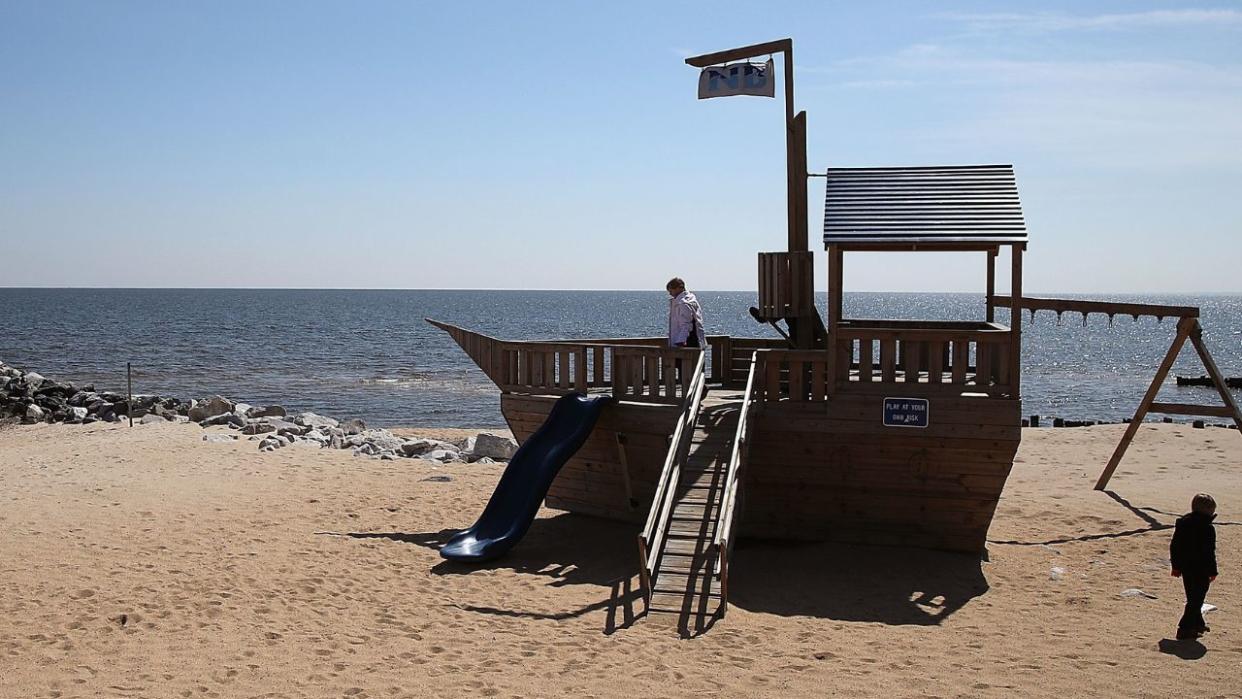Carr’s Beach, A Once Black-Owned Beach Along The Mid-Atlantic’s Chesapeake Bay, Is Being Restored To Preserve Its History

- Oops!Something went wrong.Please try again later.
- Oops!Something went wrong.Please try again later.
An area in the DMV known as Chesapeake Bay is home to multiple beaches along its shorelines. During the Jim Crow Era when segregation ran deep, the Black community wasn’t welcome to enjoy the sandy shores, according to CBS News.
Black Americans were blocked from having access to multiple beaches in the Chesapeake Bay due to the “white-only beaches.” A slave-turned-free man named Frederick Carr bought a portion of a beachfront property on the Annapolis Neck Peninsula. After he passed away, his daughters, whom he left the land to, created two beaches, Carr’s Beach and Sparrow’s Beach, housed beside each other. They both were known to host music artists “in the 6,000-seat amphitheater,” according to The Washington Post. It grew to be a popular place of leisure in the 1930s since it was one of the only resorts that offered its services to people of color.
News of the vacation property traveled further after William Lloyd “Little Willie” Adams bought a few actors of the land and invested money to build “a pavilion with a bandstand, brought in slot machines and put up a Ferris wheel.” It soon became a nationally recognized destination for Black entertainment. Visitors saw performances from legendary Black musicians, including Ray Charles, James Brown, Bo Diddley, Ray Charles, Marvin Gaye, Billie Holiday, Otis Redding, Little Richard, Smokey Robinson, Sarah Vaughan, Jackie Wilson, Gladys Knight and the Pips and Stevie Wonder.
“The epicenter for Blacks wanting to swim and enjoy the sun or hear one of their favorite acts — Sarah Vaughan, Ella Fitzgerald, the hardest working man in show business, James Brown,” Roslyn Johnson, the Rec & Parks director with the City of Annapolis, said in an interview with CBS News.
Once in the mid-50s, a crowd of nearly 50,000 people gathered to see rock and roll pioneer Chuck Berry in concert.
“This place was the mecca of Black entertainment in the mid-Atlantic region,” said Vincent Leggett, founder and president of the Blacks of the Chesapeake Foundation, per The Washington Post. “There’s just so much African American history and heritage along this stretch.”
The background of Carr’s Beach has often been overlooked, until now. Annapolis city government leaders have agreed to ensure the history of the location, which became a haven for Black Americans in the area where they could relax and have fun during a time of oppression, lives on.
Joel Dunn, President and CEO of Chesapeake Bay Conservancy, shared that it’s time for narratives similar to Carr’s Beach to be told because “these stories that occurred here have been left untold for too long.”
Most of the sacred region no longer belongs to the Carr family because it was sold and other project developments were built. The city of Annapolis purchased the five-acre strip section called Elktonia Beach in 2022. To complete their vision to keep the legacy of Carr’s Beach alive, officials purchased some additional land formerly owned by Coppin State University President Dr. Parlett Moore.
“With this house becoming available, it gives us the opportunity to knock it down and build a beautiful center that celebrates that history,” Annapolis Mayor Gavin Buckley told CBS News.
“That beach is going to be beautiful and enjoyable. We’re going to rehabilitate the piers here. There’s going to be a 12 or 13 minute ferry to bring people from downtown,” he later added.
The real estate investments will be integrated and named Elktonia-Carr’s Beach Heritage Park and will be overseen by the city. A visitor’s center, which will also serve as the headquarters for Blacks of the Chesapeake, has been included in the layout of the construction plans along with a revamped shoreline, “building trails, and educational signage about the history of the site.”
“We’ve been able to preserve the sand, the beach and the water and the dirt and tell the story of Black life on the Chesapeake Bay from an authentic space,” Vince Leggett, Executive Director of the Blacks of the Chesapeake, said to CBS News.
The new landmark’s infrastructure will cost an estimated $9 million and will begin and last until August 2024. It will take place over the next 18 months and will involve restoring the shoreline, as well as building trails and educational signage about the history of the site.
“This Black history will not be a footnote,” Dunn said to CBS News. “It never should have been, but it won’t be ever, moving forward.”

